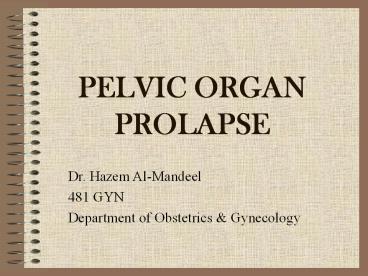PELVIC ORGAN PROLAPSE - PowerPoint PPT Presentation
Title:
PELVIC ORGAN PROLAPSE
Description:
... Rectal prolapse Classification of Prolapse Baden Walker (1972) Each site graded from 1 4 POPQ: ... – PowerPoint PPT presentation
Number of Views:208
Avg rating:3.0/5.0
Title: PELVIC ORGAN PROLAPSE
1
PELVIC ORGAN PROLAPSE
- Dr. Hazem Al-Mandeel
- 481 GYN
- Department of Obstetrics Gynecology
2
Objectives
- To define pelvic organ prolapse
- Recognize pelvic anatomy
- Determine the Pathophysiology
- Discuss the predisposing factors
- Understand the grading systems
- Be aware of the options of management
3
Pelvic Organ Prolapse
- Is the descent of the pelvic organs as a result
of the loss of muscular and fascial structural
support .
4
Anatomic Supports
- Muscular Levator Ani (Pelvic Floor Ms.)
- Ligaments Uterosacral-Cardinal Complex
- Fascial Endopelvic (Pubocervical
Rectovaginal)
5
Levator Ani
- Major structure of pelvic floor
- Anterior/posterior orientation
- Perforated by urogenital hiatus
- Consists of Pubococcygeus
- Iliococygeus
- Puborectalis
- Coccygeus
6
(No Transcript)
7
(No Transcript)
8
Endopelvic Fascia
- Fibromuscular layer
- Local condensations are ligaments
- Principal ligaments are Uterosacral
-
Cardinal - Pubocervical and Rectovaginal Fascia important in
specific surgical correction
9
(No Transcript)
10
(No Transcript)
11
(No Transcript)
12
Pathophysiology
- Direct Trauma to pelvic soft tissues
- Neurological injury
- Connective tissue disorders
13
Predisposing Factors
- Hereditary (genetic) predisposition
- Race White gt Black gt Asian
- Pregnancy and Vaginal Childbirth
- Age and Menopause
- Raised intra-abdominal pressure (e.g. obesity,
cough, constipation, lifting, etc) - Iatrogenic surgical procedure
14
Types of Pelvic Organ Prolaopse
- 1. Urethra
- 2. Bladder
- 3. Uterus/ Vaginal Vault
- 4. Small Bowel
- 5. Rectum
- 6. Perineum
15
Compartments
- Anterior Cystocele
- Urethrocele
- Middle Uterine prolapse
- Enterocele/vault prolapse
- Posterior Rectocele
- Rectal prolapse
16
(No Transcript)
17
(No Transcript)
18
(No Transcript)
19
(No Transcript)
20
(No Transcript)
21
Classification of Prolapse
- Baden Walker (1972)
- Each site graded from 1 4
- POPQ quantifies using specific points
- Measured relation to the hymenal ring
- More widely used
22
Symptoms of Prolapse
- Pelvic pressure
- Pelvic pain
- Feeling of a lump
- Back pain
- Urinary dysfunction
- Bowel dysfunction
23
Complications of Prolapse
- Bleeding
- Infection
- Recurrent UTIs
- Urinary obstruction
- Renal failure
24
Associated conditions
- Urinary Incontinence Stress
- Urge
- Mixed
- Fecal Incontinence sphincter injury
25
Options of Management
- No Treatment ( pelvic floor exercise)
- Conservative such as
- Physiotherapy or Pessary
- Surgical Treatment
26
(No Transcript)
27
(No Transcript)
28
Aims of prolapse surgery
- Alleviate symptoms
- Restore normal anatomy
- Restore normal visceral function
- Avoid new bladder or bowel symptoms
- Preserve sexual function
- Avoid surgical complications
29
(No Transcript)
30
Conclusions
- Pelvic organ prolapse is common
- Results from injury to soft tissue and nerves
- Childbirth most significant association
- Treatment requires understanding of anatomic
relationships - Treated with a combination of physio/pessary and
often complex surgery































